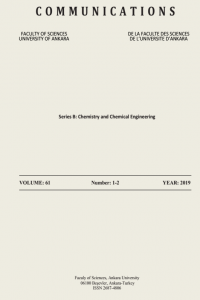The Investigation of Chromate Reduction With Rhodium and Iridium Electrodes*
In this work, the cathodic reduction of chromate ion with rhodium and iridium elect¬rodes in acidic bichromate solution was investigated. For this purpose, cathodic pola- rization curves were obtained through an electronic potentiostat with oxidized and reduced electrodes in 1 N H2SO4 and together with various concentrations of K2Cr2O7. In each electrode chromate reduction occurred at the reduction potential of the metal oxide in 1 N H2SO4. According to other investigators practically no chromate reduction occurs at the positive potentials and it drifts toward the negative side where the hydrogen discharge take place. In this work, a potential step which is related to the chromate reduction in the positive potential region was found. This step drifts to the negative potential when bichromate concentration is increased.
It was shown that the limiting current was proportional with the bichromate con¬centration in a definite region. Particularly with iridium electrode, these proportionalities are effective only around very small concentration region.
In addition, hysteresis curves were obtained with oxidized and reduced iridium and rhodium electrodes in 1 N H2SO4 + 7. 5.10-6 M K2 Cr2 O7 and 10“3 N H2SO4 + 7. 5.10”6 M K2Cr2O7 + 1 N Na2SO4 Solutions.
In these studies, it was concluded that the film formed by cathodic reduction on the electrode surface and it has different composition and thickness in acidic and weak acidic Solutions.
___
- Ankara Üniversitesi Communications, Series B: Chemistry and Chemical Engineering
